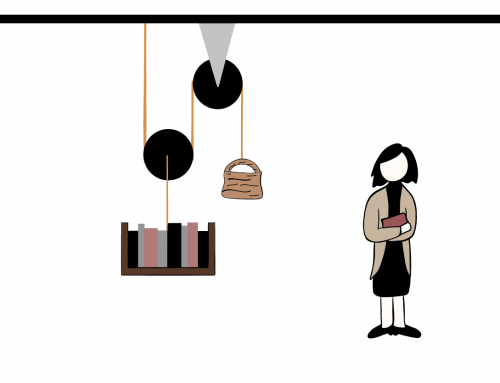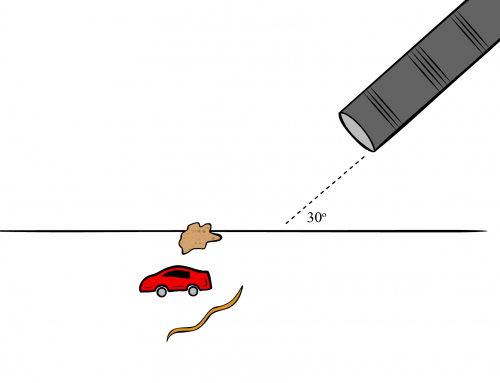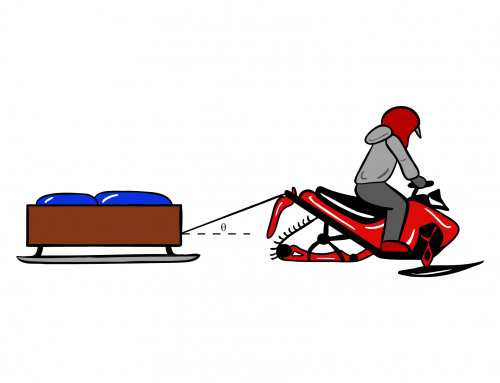Lisa is trying to move a couch in her living room. Lisa checks her filing cabinet for the paperwork that came with the couch, and determines that the mass of the couch should be 300 kg based on the manufacturer’s specifications. Initially, the couch does not budge, but when Lisa exerts any force greater than 700 N, the couch suddenly starts to move. Lisa keeps pushing the couch with that same force, and the couch accelerates at \(0.1 \, \text{m}/{\text{s}^2}\).
a) What must be the coefficient of static friction between the couch and the floor?
b) What must be the coefficient of kinetic friction between the couch and the floor?
a) Once you draw the free-body diagram, you can use the normal force and the maximum force due to static friction to get the coefficient of static friction.
b) On the free-body diagram, there will be an acceleration along the \({x-}\)axis. Proceed similar to part a) to get the coefficient of kinetic friction.
a) In this case, the maximum force due to static friction is:
\begin{equation*}
f_{r_{max}}=\mu_s N,
\end{equation*}
where we need to know \(f_{r_{max}}\) and \(N\) to get \(\mu_s\).
From Newton’s Second Law in the \({y-}\)direction, we have:
\begin{equation*}
N-mg=0,
\end{equation*}
so \(N=mg\). Newton’s Second Law in the \({x-}\)direction gives us:
\begin{equation*}
F_l – f_{r_{max}} = 0,
\end{equation*}
then \(F_l = f_{r_{max}} = 700 \, \text{N}\). Solving for \(\mu_s\) in the first equation and replacing the variables with numerical values, we obtained:
\begin{equation*}
\mu_s = 0.238.
\end{equation*}
b) Now, the kinetic friction force is:
\begin{equation*}
f_{r_{k}}=\mu_k N,
\end{equation*}
where \(N\) is the same as in a). Solving Newton’s Second Law for the \({x-}\)direction, we get:
\begin{equation*}
F_L – f_{r_k} = m a_x,
\end{equation*}
where we can solve for \(f_{r_k}\) to substitute into the previous equation. This gives:
\begin{equation*}
\mu_k = \frac{{(F_L – ma_x)}}{{(mg)}},
\end{equation*}
and plugging in numerical values:
\begin{equation*}
\mu_k = 0.227.
\end{equation*}
For a more detailed explanation of any of these steps, click on “Detailed Solution”.
\begin{equation}
\label{Lisa_staticfriction}
f_{r_{max}}=\mu_s N,
\end{equation}
where \(\mu_s \) is the coefficient of static friction and \(N\) the magnitude of the normal force. Thus, to find \(\mu_s \) we need to find this maximum force and \(N\). In particular, if we divide by \(N\), we get
\begin{equation}
\label{Lisa_mu}
\frac{f_{r_{max}}}{N} = \mu_s.
\end{equation}
Now, we know that the static friction is a force that counterbalances those external forces that attempt to move the object over a surface. In this case, the static friction of the couch counterbalances Lisa’s force over the couch. The greater the force Lisa exerts on the couch, the greater the static friction between the couch and the floor. This is why the couch does not move while Lisa increases the force she uses to push it: as she increases such force, the static friction also increases so that the total force along the floor is exactly zero and the couch remains in place. Thus, one can find the friction by finding the external forces on the couch, for these forces will have the same magnitude but opposite directions (they have opposite directions so that the total sum is zero, and the object remains at rest).
Given this, we want to find the maximum force Lisa can exert on the couch before it starts moving. That force will then be of the same magnitude as the maximum static friction. Fortunately, we know what force is this: the prompt says that when Lisa pushes the couch with any force greater than 700 N, then the couch suddenly starts moving. This must mean that 700 N is the maximum static friction between the couch and the floor. If Lisa applies a force greater than this, the couch moves, meaning that the friction can no longer counterbalance the external forces.
So we know that \(700\, \text{N}\) is \(f_{r_{max}}\) in equation \eqref{Lisa_mu}. But to use that equation, we still need to find \(N\). This force can be obtained by considering Newton’s Second Law in the vertical direction. Let’s assume that Lisa pushes the couch in the positive X-axis. Then, the weight acts in the negative \({y-}\)direction, and the normal in the positive \({y-}\)direction, as indicated in Figure 1.
Figure 1: Force diagram for the couch. The forces exerted on it are the contact force with the ground \(N\), the weight \(W\), the friction \(f_r\), and the force exerted by Lisa \(F_l\). The coordinate axis is chosen with X on the horizontal and Y on the vertical.
Then, Newton’s Second Law along \({y}\) yields:
\begin{equation}
N \, \hat{\textbf{j}} -W \, \hat{\textbf{j}}= m a_y \, \hat{\textbf{j}}.
\end{equation}
But since the couch is not moving vertically, \(a_y =0\), we get
\begin{equation}
N \, \hat{\textbf{j}} = W \, \hat{\textbf{j}}.
\end{equation}
If we focus on the magnitudes only, and we use the relationship \(W=mg\), we get
\begin{equation}
\label{Lisa_Normal}
N = mg.
\end{equation}
Finally, we can use this in equation \eqref{Lisa_mu}:
\begin{equation}
\frac{f_{r_{max}}}{{(mg)}} = \mu_s.
\end{equation}
If we plug in numerical values:
\begin{equation}
\frac{{(700 \, \text{N})}}{{(300\, \text{kg})} {(9.8 \, \text{m/s}^2)}} = \mu_s,
\end{equation}
we get:
\begin{equation}
\label{Lisa_muResultado}
0.238 = \mu_s.
\end{equation}
b) Once the couch starts moving, the friction between the couch and the floor is kinetic and not static. We know that the force due to kinetic friction is always given by
\begin{equation}
f_{r_k}=\mu_k N,
\end{equation}
where again, \(N\) is the normal force. So the reasoning is similar to the previous case; from \(f_{r_k}\) and \(N\), we can find \(\mu_k\):
\begin{equation}
\label{Lisa_muK}
\frac{f_{r_k}}{N} = \mu_k.
\end{equation}
But how do we get \(f_{r_k}\) if we do not know \(\mu_k\)? Well, we know the acceleration of the couch along \({x}\) (which is the direction of motion), and we know that there are only two forces along \({x}\): the force due to friction and the force due to Lisa. Thus, from Newton’s Second Law in the \({x-}\)direction, we get
\begin{equation}
F_L \, \hat{\textbf{i}} – f_{r_k} \, \hat{\textbf{i}} = m a_x \, \hat{\textbf{i}},
\end{equation}
where \(F_L\) is Lisa’s force. If we move \(f_{r_k}\) to the right side, and we focus on the magnitudes only, we get
\begin{equation}
F_L = ma_x + f_{r_k}.
\end{equation}
Let’s now move \(m a_x\) to the other side:
\begin{equation}
F_L – m a_x = f_{r_k}.
\end{equation}
We can then use this in equation \eqref{Lisa_muK} and the fact that \(N = W\) (i.e. \( N = mg \)):
\begin{equation}
\frac{{(F_L – ma_x)}}{{(mg)}} = \mu_k.
\end{equation}
Finally, let’s plug in numerical values:
\begin{equation}
\frac{{(700 \, \text{N})} – {(300\, \text{kg})} {(0.1 \, \text{m/s}^2)}}{{(300\, \text{kg})} {(9.8 \, \text{m/s}^2)}} = \mu_k,
\end{equation}
to get:
\begin{equation}
0.227 = \mu_k.
\end{equation}
Notice here that the coefficient of kinetic friction \(\mu_k \) is smaller than the coefficient of static friction \(\mu_s \). This is the reason why it is harder to set an object in motion than to keep moving it.
You need to be registered and logged in to take this quiz. Log in






Leave A Comment